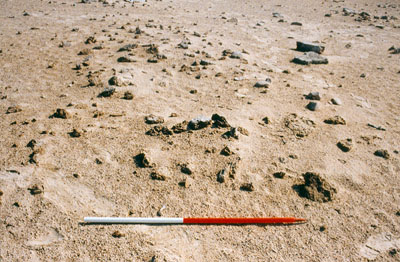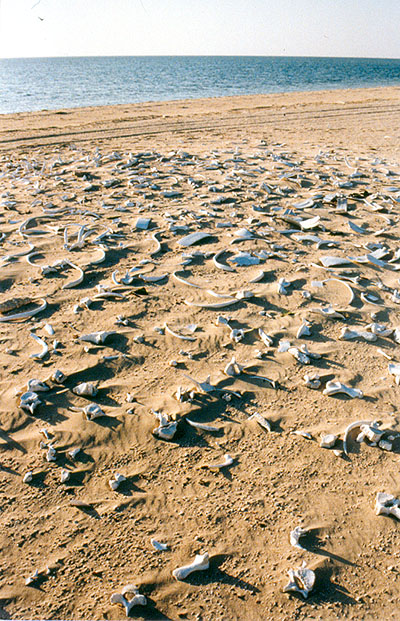The Abu Dhabi Islands Archaeological Survey (ADIAS) has, since its creation in 1991, sought to survey, record and where appropriate, excavate archaeological sites on the coast and islands of Abu Dhabi, one of the seven emirates that make up the United Arab Emirates, in south-east Arabia (King 1998, 7). Recent seasons have focused on islands situated in the shallower waters of North-East Abu Dhabi.

Figure 1: A satellite image of the island of Abu'l-Abyadh, showing the position of archaeological sites.
The largest of these islands, and indeed the largest of any of the more than 200 islands in UAE territory, is Abu'l-Abyadh. This lies around 55 kilometres south-west of Abu Dhabi city, around 8 kilometres north of the mainland of Arabia. The island measures around 35 kilometres east-west by 15 kilometres north-south, representing a large area of unexplored territory. In January and February 2001, a team from the Abu Dhabi Islands Archaeological Survey, led by Daniel Hull and Stephen Rowland, completed the first systematic archaeological survey of the island (Hellyer et al 2001; Hellyer & Hull 2002).
This survey located 51 archaeological sites, almost all of which are situated on the island's coastline. Very few sites were found in the interior of the island, since this area was, until recent construction and drainage projects there, made up of low-lying, inter-tidal sand flats.

Figure 2: A pre-excavation photograph of one the hearths sampled for charcoal, for Carbon 14 dating.

Figure 3: Foundations of a Late Islamic, palm frond structure, on the south coast of the island.
The sites consist largely of surface features, such as hearths, structures, and middens, as well as artefact scatters, primarily of pottery and flint. The dating of the majority of these sites remains ambiguous, but analysis of pottery scatters within and around each site by Dr. Robert Carter (Institute of Archaeology, UCL; Hellyer et al 2001) has given some interesting indications. One site yielded pottery of the 'Ubaid period (that is, the sixth and fifth millennia BC). Three other sites produced pottery suggestive of the Late Pre-Islamic, or Early Islamic, periods (the fifth to eighth centuries AD). Since 28 of the 29 sites with pottery scatters produced sherds of Late Islamic date, the majority of human activity on the island is likely to date to between the fourteenth century and the arrival of oil-based industrial development in the UAE in the 1950s.
Since it has often been found to be the case on the islands of Abu Dhabi that Late Islamic sherds occur in conjunction with sites of earlier periods, a series of minor excavations were carried out on surface hearths in order to provide dates from Carbon 14 analysis. The forthcoming results are awaited with interest.
Preliminary spatial analysis of the location of Late Islamic structures, whether secular in the form of foundations for palm frond houses, or religious in the form of 'outline' mosques, reveals that the majority of settlement took place on the far south-west tip of the island, at a place known locally as Ra's Muqayshit, and on the north-west coast at Ra's al Hadhra. The distribution of sherds of large storage vessels corresponds with these two centres of settlement, as does the presence of Islamic graves. However, even at these two locations, oral historical evidence provided by older members of the Rumaythat subsection of the Bani Yas tribe, whose ancestors are believed to have been the primary occupiers of the coast and islands of North-East Abu Dhabi, reveals that very few settlements on the islands of the Lower Gulf were ever permanent, with Abu Dhabi island, Dalma, Ghagha and Sadiyat the only exceptions due to the presence of ground water there. On the majority of islands, Abu'l-Abyadh included, a pattern of migration took place until the 1950s which was based on the harvesting of abundant marine faunal resources. Preliminary observations of a number of middens located during the survey indicate that a diverse range of species were exploited. In evidence were reptiles, especially the green turtle Chelonia mydas, marine mammals, such as the dugong Dugong dugon and dolphins Delphinus sp., seabirds, including the Socotra Cormorant Phalocrocorax nigrogularis, shellfish such as the spiny oyster Spondylus marisrubri and the gastropod Hexaplex kuesterianus, as well as fish, among them shark Carcharhinus sp., stingray Dasyatis uarnak and hamour (or grouper) Epinephelus tauvina.

Figure 4: One of a large number of middens on Abu'l-Abyadh. This example displays evidence for dugong and green turtle

Figure 5: Detail of a Pinctada radiata midden.
An important aspect of the economy of this period was pearl fishing. The shallow waters of the southern Arabian Gulf, and especially those pertaining to the Emirate of Abu Dhabi, are host to great numbers of pearl beds, many of which lie immediately to the north and north-west of Abu'l-Abyadh. The survey found extensive evidence of pearl fishing, especially to the north-west, where the processing of at least one species of pearl oyster Pinctada radiata was carried out, until the near-collapse of the industry during the 1930s. The oral historical research also provided evidence for this practice. One particular midden was found to measure over 3 kilometres in length, and is estimated to contain between 50 and 100 million shells.
ADIAS plans to carry out further, more intensive, work on Abu'l-Abyadh in forthcoming seasons.
References- Hellyer, P., Hull, D.J. & Rowland, S. (2001) An archaeological survey of the island of Abu al- Abyadh, Abu Dhabi, United Arab Emirates. Unpublished report.
- Hellyer, P. & Hull, D. (2002) 'The Archaeology of Abu Al Abyad', in R.J.Perry (ed) The Island of Abu Al Abyad Abu Dhabi: ERWDA: 17-38
- King, G.R.D. (1998) Abu Dhabi Islands Archaeological Survey: Season 1. An archaeological survey of Sir Bani Yas, Dalma and Marawah London: Trident Press.
Hull, Abu Dhabi Islands Archaeological Survey, PO Box 45553. danielhull@yahoo.com
Rowland, Abu Dhabi Islands Archaeological Survey, PO Box 45553. stephenrowland@yahoo.co.uk